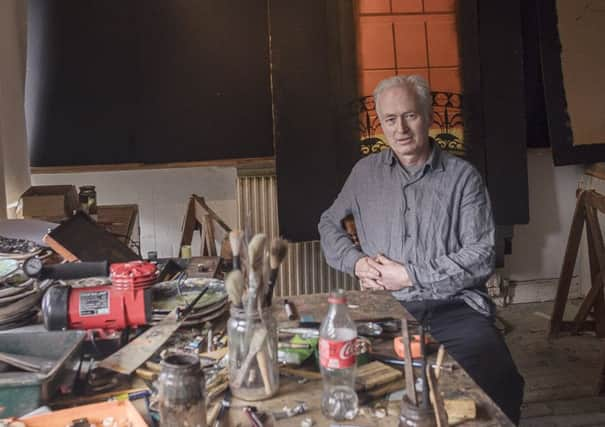Hugh Buchanan: Celebrating the classical heart of a city built by a '˜mad god'


I was sitting in a bus on South Bridge outside Edinburgh University’s Old College. It was early December 2015 and the driving rain from an easterly gale was soaking Robert Adam’s triumphal entrance. The drenched masonry and columns, normally subtle shades of sludge green and dove grey, had been turned for the moment, by the rainwater, into a monumental dark mirror. Reflected in this ancient Roman grandeur were the red traffic lights and tail lights of the stationary traffic. I had been asked six months before by the Scottish Gallery to paint a series of paintings celebrating 250 years of the New Town and was running out of time. I had been wondering how to tackle the project in a way that was relevant to today. Here was my first subject.
I soon realised that artificial light, be it floodlights or traffic lights, has transformed the way we see the city so I wasn’t long in finding other subjects. Indeed it is hard to find a building of any importance now that is not lit up at night. It has provided a drama that was unavailable to previous generations. The Dean Institute, Surgeons Hall and Dundas House were soon added to my list.
Advertisement
Hide AdAdvertisement
Hide AdBut they were not all to be night scenes. One thing I knew I wasn’t going to do was views of George Street. How do you handle the cars and the general street clutter? Rows of Range Rovers and Fords were never part of my agenda. However I realised that if I got close enough to them I could, like the American photorealists, use them as mirrors. An added benefit was that I could legitimately use the colours of the cars in the reflections. In this way I described Regent Bridge, Charlotte Square and St Stephen’s Church. This is in fact how we so often see the New Town, glimpsed in a fragmented fashion as we nervously check for parking tickets. Indeed the main hazard, as I peered intently at the windscreens of parked cars, was that rather angry people took me for a plain clothes traffic warden.
I had tackled light outside buildings but there was also light from within. We have all peered up at New Town windows before the curtains are drawn, wondering who on earth lives there and what do they do? That slight sense of exclusion is a very Edinburgh sensation and I have sought to capture that feeling in a series of paintings of partially drawn blinds and wrought iron balconies - with particular reference to Cadell’s famous painting The Orange Blind.
Although there is undoubtedly a sense of elegant reserve about the New Town it is, in its conception, a fundamentally democratic model. The pedimented street fronts, from the grandeur of Charlotte Square to the relative simplicity of Forth Street, are not, as their critics claim, elitist. Quite the opposite. They declare that everyone lives in a palace. Not the palace of a tyrant but a palace of the demos, enlightened people sharing an Enlightenment ideal under one long roof. Likewise the shared gardens and the intermixing of tenement flats with grand mansions in streets like Great King Street mean that it is impossible to tell the rich from the (relatively) poor.
You don’t have to live in the New Town to feel its influence. Although its interiors are lavish, the decoration spills out on to the streets in abundance. So, even on a trip to the dentist in a New Town crescent, we encounter countless classical signals in the wrought iron and the stonework that tell us that this city was built, as Hugh MacDiarmid put it, by a ‘Mad God’.
Nor is there any diminution in the quality of detail as the New Town begins to peter out towards the top of Leith Walk. Stroll down Broughton Street and on your left is a handsome wreathed double doorway, immortalised by the photographer Edwin Smith, and every bit as grand as anything in Heriot Row. The New Town finishes with a flourish with an exquisite curved colonnade on the corner of Annandale Street. It is all a little sudden. It feels as if the architect intended to continue all the way to Prestonpans. And why not?
Current architectural thinking tends to endorse the theories of the Czech modernist Adolf Loos: that ‘ornament is a crime,’ and yet the ornaments of classical Edinburgh - the columns the friezes, the wreaths, the key patterns in the railings, are more than decoration, they all mean something. They are the Spartan poetry of a stern, rational east coast Scotland. The Spartan poetry that tells you that everyone, so long as they put salt in their porridge, is a potential Greek or Roman Hero.
A speaker at a planning conference at the Royal High School last year declared that all classical buildings are ‘soaked in blood’, symbolic as they are of colonial oppression and slavery. This is absurd on so many levels particularly when we consider the enlightenment ideals that created the New Town and the Royal High School. When taken in conjunction with the views of the Bauhaus, currently fashionable in Planning Departments, that even pitched roofs are elitist because along with their cornices or guttering they ‘represent a crown’, it is not hard to understand the threat under which our heritage finds itself.
It is modernism with its leaky roofs and arid doctrines that has failed us. Let’s make the next new town we build a classical one.
‘New Town’ is at The Scottish Gallery on Dundas Street from 7 June – 1 July.